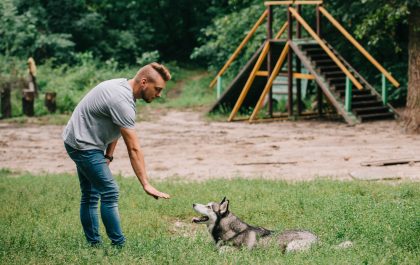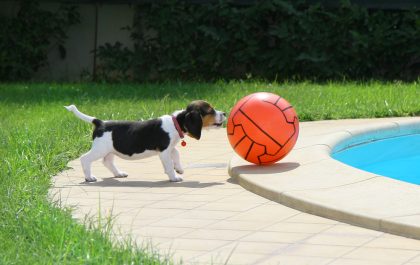Size: Large, males 70-80 cm at the shoulder, females 65-70 cm.
Weight: Males 50-60 kg, females 40-50 kg.
Coat: Thick, corded fur that forms natural dreadlocks.
colour: White, ivory, or cream.
Temperament: Loyal, protective, independent, and intelligent.
Energy: Moderate, not overly energetic but requires daily exercise.
Lifespan: 10-12 years.
Health Issues: Hip dysplasia, bloat, and eye problems.
Grooming: Daily brushing and regular bathing to prevent matting.
Training: Requires firm and consistent training from a young age.
Are you looking to learn more about the Komondor, one of the most unique and interesting breeds of dog? If so, you’ve come to the right place! In this article, we’ll explore the history and characteristics of the Komondor, one of the oldest and most beloved breeds of dog. We’ll also discuss why the Komondor is such a popular breed in Australia and how to care for one. So, if you’re interested in learning more about this remarkable breed of dog, read on!
History and Origin of the Komondor Breed
The Komondor is a breed of large, long-haired, white Hungarian sheepdog. It is believed to have descended from Tibetan dogs brought to Hungary by nomadic Magyar tribes in the 9th century. The breed was used to guard flocks of sheep and cattle, and its long, corded coat provided protection from the elements and predators.
The Komondor was officially recognized as a breed in the early 20th century. It was first imported to the United States in the 1930s, and the American Kennel Club (AKC) recognized the breed in 1937. The breed is still used as a working dog in Hungary and elsewhere, but is also popular as a companion animal. The Komondor is known for its loyalty and protective nature, and its distinctive coat has made it a popular show dog as well.
Physical Characteristics and Appearance of the Komondor
The Komondor is a large and imposing breed of dog, originating in Hungary. They have a long, shaggy white coat which is often likened to a mop. The coat is made up of two layers; the top layer is wavy and the bottom layer is corded. The coat is designed to protect the Komondor from the elements, and is often used to camouflage them in the countryside.
The average Komondor stands at around 27 inches tall and weighs between 80 and 100 pounds. They have a broad chest and a muscular frame, and their head is large and square. Their eyes are dark brown and their ears are long and drooping. The Komondor has a long tail which is often carried in a curl over their back. They have strong, thick legs and large, webbed feet. The Komondor is an impressive and imposing breed, and is sure to make an impression wherever they go.
Temperament and Personality Traits of the Komondor
The Komondor is a large, powerful breed of dog that has a strong, independent temperament. They are known for their loyalty and protective nature and are often used as guard dogs. They are also known for their intelligence and have a strong sense of self-preservation. Komondors are usually very friendly and gentle with their family, but can be aloof and wary of strangers. They are also very protective of their home and family and will bark to alert their owners of any potential danger.
Komondors have a strong, independent personality and can be quite stubborn. They need an experienced owner who can provide strong leadership and consistent training. They are very loyal and devoted to their family and will go to great lengths to protect them. They are also very intelligent and can learn quickly, but may need some extra patience and guidance. Komondors are also very active and need plenty of exercise to stay healthy and happy. They thrive in an environment with plenty of space to roam and explore.
Training and Exercise Needs of the Komondor
Komondors are a large and powerful breed of dog, and as such they have specific training and exercise needs. These needs should be taken into consideration when deciding whether or not to adopt a Komondor.
Komondors require a lot of exercise to stay healthy and happy. They should be taken for regular walks and given plenty of opportunity to run and play. They will also benefit from activities such as agility training and retrieving. As they are a large breed, they should not be over-exercised, as this can cause joint and muscle problems.
Komondors also require training in order to be well-behaved and obedient. They are intelligent and eager to please, so they can be trained relatively easily. They should be socialised from a young age, as this will help them to be comfortable in a variety of situations. Training should be positive and consistent, with rewards for good behaviour. This will help to ensure that the Komondor is a well-mannered and obedient pet.
Grooming and Coat Care for the Komondor
The Komondor is a large Hungarian herding breed of dog with a distinctive coat of long, corded hair. Proper grooming and coat care is essential to the health and well-being of the Komondor. Regular brushing and combing of the long cords is necessary to keep them from becoming matted and to remove dirt and debris. The Komondor should be bathed only as needed, as over-bathing can strip the natural oils from the coat.
In addition to regular brushing, the Komondor’s coat should be divided into cords every few months. This is done by separating the sections of the coat with a comb and then twisting each cord until it is tight. This helps to keep the coat looking neat and prevents the cords from becoming matted. As the cords grow longer, they should be trimmed to a manageable length. It is important to use sharp scissors when trimming the cords, as dull scissors can cause damage to the coat. Finally, the Komondor’s nails should be trimmed regularly to prevent them from becoming overgrown.
Health Issues and Concerns for the Komondor
The Komondor is a large and powerful breed of dog that requires considerable care and attention to its health. As with any breed, there are some health issues and concerns that owners should be aware of.
The most common health issue in the Komondor is hip dysplasia, which is a condition that affects the hip joints. This can lead to arthritis and other joint problems, and can be painful and debilitating for the dog. Other health issues that Komondors may be prone to include eye problems such as cataracts, and skin conditions such as dermatitis. It is important to monitor the dog’s health and to take them for regular check-ups with the vet in order to ensure any health issues are detected and treated early.
Komondors also have a tendency to gain weight easily, and it is important to ensure that the dog is not overfed and that they get enough exercise. This will help to keep the dog in good condition and prevent any weight-related health issues from developing. Komondors are also prone to ear infections, so regular cleaning and inspection of the ears is important in order to maintain good ear health.
Komondors as Working Dogs: Past and Present Roles
Komondors have a long history as working dogs, dating back to the 16th century in Hungary. Originally bred to guard livestock, the breed was used to protect the flocks from predators such as wolves and bears. They are known for their courage and loyalty, and have since been used in a variety of working roles.
In the present day, Komondors are still used as working dogs, although their roles have changed somewhat. They are now used as guard dogs, police dogs, and search and rescue dogs. They are also used as therapy dogs, and are known for their intelligence, obedience, and affectionate nature. They are a popular choice for families looking for a loyal and protective companion.
Finding and Choosing a Komondor: Tips for Prospective Owners
Finding and choosing a Komondor can be a daunting task for prospective owners. The breed is known for its impressive guarding abilities, distinctive appearance, and its role in Hungarian culture. To ensure that you find the perfect Komondor for your family, there are several tips to keep in mind.
Firstly, it is important to research the breed thoroughly before making a purchase. This includes learning about their temperament, health concerns, and training needs. It is also important to find a reputable breeder who can provide you with a healthy and well-socialised puppy. Ask for references from other Komondor owners, and be sure to visit the breeder’s premises to meet the puppy and its parents.
Once you have found the perfect puppy, it is important to establish a routine for its care. This includes providing adequate exercise, a healthy diet, and regular grooming. Establishing a positive relationship between you and your Komondor is also essential, so make sure to spend quality time with your pet. With the right care and attention, a Komondor can make a wonderful addition to any family.
Final Thoughts
The Komondor is an impressive and unique breed of dog that is sure to make an impression wherever they go. They are loyal and protective of their family, and can make excellent guard dogs. They require an experienced owner who is willing to provide consistent training and socialisation. The Komondor is an active breed, and needs plenty of exercise and mental stimulation. They do best in a rural environment with plenty of space to roam and explore. With the right owner, the Komondor can be a loving and devoted companion. If you are looking for a unique and loyal companion, the Komondor may be the perfect fit for you.
Komondor FAQs
Komondors can be great with children if they are socialized and trained properly. However, they may not be the best choice for families with very young children due to their protective instincts.
Yes, Komondors can be trained, but they require a firm and consistent approach. They are independent thinkers and may not always obey commands.
Komondors are large dogs that can weigh anywhere from 36 to 61 kilograms and stand up to 76 centimetres tall at the shoulder.
The Komondor is a Hungarian breed of livestock guardian dog.
The Komondor’s coat requires a lot of maintenance, including regular brushing, bathing, and trimming. The cords can take up to 2 years to fully form.
The Komondor breed has been around for over 1,000 years and was originally bred to guard sheep and other livestock.
The average lifespan of a Komondor is around 10 to 12 years.
Komondors have been an important part of Hungarian culture for centuries and are considered a national treasure. They were used to guard livestock and were highly valued by shepherds and farmers.
Komondors are known for their loyalty, protectiveness, and independence. They can be wary of strangers and require proper socialization and training.
The most distinctive feature of the Komondor is its long, corded coat, which serves to protect it from predators.





